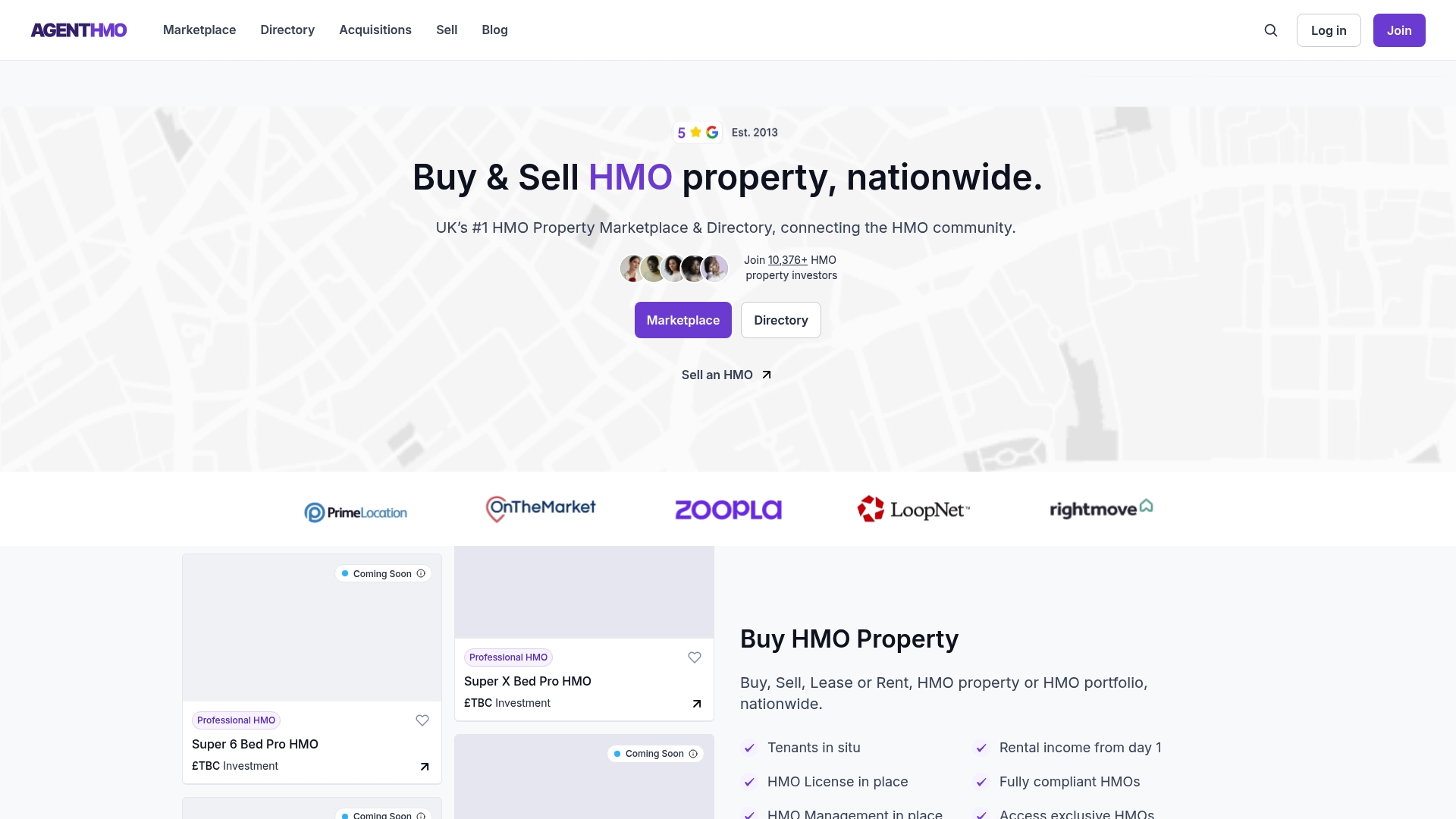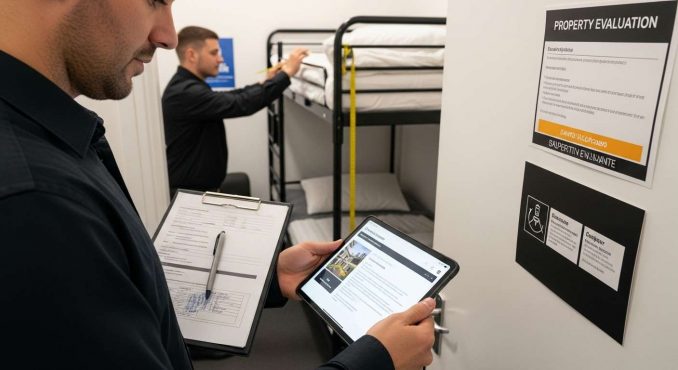Selling an HMO property can look daunting, especially when faced with complex regulations and investor scrutiny. Yet, over 60 percent of HMO sales in the UK fall through due to poor preparation or documentation. Most landlords focus only on sprucing up the property, but the real edge comes from mastering every detail, from legal compliance to market timing. Skip those basics and you might watch buyers walk away, but get it right and your HMO can stand out as a truly irresistible investment.
Table of Contents
- Step 1: Evaluate Your Property And Market Conditions
- Step 2: Prepare Your HMO For Sale
- Step 3: Obtain Accurate Valuation And Documentation
- Step 4: Market Your HMO Effectively
- Step 5: Conduct Viewings And Negotiate Offers
- Step 6: Finalise Sale And Transfer Ownership
Quick Summary
| Key Point | Explanation |
|---|---|
| 1. Conduct a thorough property evaluation | Assess structural integrity, rental income, and compliance to enhance marketability. |
| 2. Address compliance and safety standards | Ensure your HMO meets UK regulations to attract potential buyers with confidence. |
| 3. Engage a professional estate agent | Their expertise helps navigate market conditions and buyer expectations effectively. |
| 4. Compile transparent financial documentation | Clear rental income statements and expenses demonstrate the property’s investment potential. |
| 5. Prepare for professional viewings | A well-presented property with comprehensive information boosts buyer interest and offers. |
Step 1: Evaluate Your Property and Market Conditions
Successfully selling an HMO property starts with a comprehensive and strategic evaluation of your asset and its current market positioning. This critical first step determines your property’s marketability, potential value, and attractiveness to prospective buyers. By conducting a thorough assessment, you will establish a solid foundation for your sales strategy.
Understanding Your Property’s Unique Characteristics
Begin by performing an objective and detailed analysis of your HMO property. Examine its structural integrity, current condition, and specific features that distinguish it from standard residential properties. Key aspects to assess include the number of lettable rooms, overall square footage, current rental income, occupancy rates, and compliance with HMO licensing regulations.
The UK Government’s HMO guidance provides critical insights into regulatory requirements that can significantly impact your property’s market value. Verify that your property meets all current safety standards, including fire safety regulations, room size requirements, and amenity provisions. Potential buyers will scrutinise these details, so addressing any compliance issues proactively can enhance your property’s marketability.
Market Condition Assessment
Transitioning from property-specific evaluation to broader market analysis is crucial. Research recent HMO property transactions in your local area, focusing on comparable properties with similar characteristics. Analyse selling prices, average time on market, and current demand trends. This data will help you realistically price your property and understand potential buyer expectations.
Consider engaging a specialist HMO estate agent who understands the nuanced market dynamics. These professionals can provide granular insights into current market conditions, potential buyer profiles, and strategic pricing recommendations. They will help you understand whether your local market favours sellers or if you need to implement additional strategies to attract potential purchasers.
Successful evaluation means having a comprehensive understanding of your property’s strengths, potential improvements needed, and its precise market position. By meticulously completing this first step, you transform your HMO property from a mere asset into an attractive investment opportunity for discerning buyers.
![]()
Step 2: Prepare Your HMO for Sale
Preparing your HMO property for sale involves strategic improvements that maximise its market value and appeal to potential investors. This crucial step transforms your property from a basic rental asset into an attractive investment opportunity that commands attention in the competitive HMO marketplace.
Property Enhancement and Compliance
Begin by conducting a comprehensive property assessment that addresses both physical condition and regulatory compliance. Safety and functionality are paramount when preparing an HMO for sale. Prioritise essential repairs and improvements that demonstrate the property’s well-maintained status. This includes updating electrical systems, ensuring proper fire safety measures, and resolving any structural issues that might deter potential buyers.
Carefully review your property against current HMO licensing requirements. Learn more about HMO property sales to understand the specific standards investors expect. Professional documentation proving compliance with safety regulations can significantly increase buyer confidence. Consider obtaining an up-to-date electrical safety certificate, gas safety record, and fire risk assessment report.
Presentation and Documentation Preparation
Investors purchasing HMO properties seek clear evidence of financial performance and potential. Compile a comprehensive information package that includes current rental income statements, occupancy rates, and a detailed breakdown of operational expenses. Transparent financial documentation can substantially improve your property’s marketability.
Visual presentation matters immensely. Professional photography that highlights the property’s best features can make a significant difference in attracting serious buyers. Consider staging key areas to showcase the property’s potential, focusing on communal spaces and demonstrating how the HMO maximises rental income potential.
Successful preparation means presenting a well-maintained, compliant, and financially attractive HMO that speaks directly to investor interests. By methodically addressing physical improvements, regulatory compliance, and financial transparency, you position your property as a compelling investment opportunity in the competitive HMO market.
Below is a checklist table to help you prepare your HMO for sale, ensuring no critical steps are overlooked during the process.
| Preparation Step | Purpose | Verification Method |
|---|---|---|
| Address essential repairs | Enhance property appeal and safety | Physical inspection |
| Ensure compliance with fire safety regulations | Meet legal requirements and reassure buyers | Up-to-date safety certificates |
| Update electrical systems | Reduce buyer concerns over costly improvements | Recent electrical safety record |
| Obtain HMO licence and certificates | Prove legal lettability as HMO | Documentary evidence |
| Compile current rental income statements | Demonstrate financial viability | Financial portfolio |
| Prepare occupancy and expense records | Provide transparency for potential investors | Organised documentation |
| Stage communal and key areas | Highlight rental income potential | Professional photography |
Step 3: Obtain Accurate Valuation and Documentation
Obtaining an accurate valuation represents a pivotal moment in your HMO property sales journey. This step transforms your property from a theoretical asset into a precisely quantified investment opportunity that attracts serious buyers and ensures you receive fair market value.
Professional Valuation Strategies
Securing a professional valuation requires strategic engagement with experienced HMO specialists who understand the nuanced property market. Professional valuers bring critical expertise in assessing multiple factors beyond simple square footage. They examine rental income potential, occupancy rates, property condition, local market trends, and specific HMO configurations that influence overall value.
Select a valuer with demonstrable experience in HMO property assessment. Explore our HMO property marketplace for recommended professional networks. During the valuation process, be prepared to provide comprehensive documentation including current rental agreements, utility costs, maintenance records, and any recent improvements that could enhance property value.
Documentation and Verification
Prepare a meticulous documentation package that substantiates your property’s value. This should include current tenant contracts, historical rental income statements, compliance certificates, and a detailed property inventory. Transparent and organised documentation significantly increases buyer confidence and can expedite the sales process.
The UK government’s guidance on HMO regulations emphasises the importance of comprehensive record-keeping. Gather all relevant legal documents, including HMO licensing information, safety certificates, and any recent structural assessment reports. These documents not only validate your property’s worth but also demonstrate your commitment to professional property management.
Successful valuation means presenting a thoroughly documented, professionally assessed HMO that provides potential buyers with absolute clarity about its investment potential. By combining expert valuation with comprehensive documentation, you transform your property from a simple asset into an attractive, transparent investment opportunity.
Step 4: Market Your HMO Effectively
Marketing an HMO property requires a strategic approach that goes beyond traditional residential property sales. This step transforms your property from a potential listing into an attractive investment opportunity that captures the attention of serious investors and property professionals.
Targeted Marketing Strategies
Develop a comprehensive marketing strategy that speaks directly to professional HMO investors. Compelling visual presentation is crucial in capturing potential buyers’ interest. Invest in high-quality professional photography that showcases the property’s unique features, highlighting rooms, communal spaces, and potential rental configurations. Create a detailed property brochure that goes beyond basic descriptions, presenting a comprehensive narrative of the property’s investment potential.
Utilise multiple marketing channels to maximise exposure. This includes specialist property investment platforms, targeted online listings, and professional HMO property networks. Craft a compelling narrative that emphasises the property’s revenue generation potential, current occupancy rates, and any recent improvements that enhance its value as an investment asset.
Investor-Focused Presentation
The UK government’s property marketing guidance underscores the importance of transparent and detailed property information. Prepare a comprehensive investment package that includes detailed financial performance data, current rental income statements, occupancy history, and potential future earnings projections. Professional investors want concrete evidence of the property’s financial viability.
Consider hosting targeted viewing sessions or virtual property tours specifically designed for HMO investors. These sessions should provide in-depth insights into the property’s operational aspects, compliance status, and potential for future income generation. Be prepared to answer detailed questions about rental yields, maintenance costs, and local market dynamics.
Successful marketing means presenting your HMO property as a sophisticated investment opportunity. By combining strategic visual presentation, comprehensive documentation, and targeted marketing approaches, you transform your property from a simple real estate asset into an attractive proposition for discerning investors.
Step 5: Conduct Viewings and Negotiate Offers
Conducting viewings and negotiating offers represent the most critical phase in selling your HMO property. This step transforms your marketing efforts into potential successful transactions, requiring strategic preparation, professional communication, and nuanced negotiation skills tailored specifically to the HMO investment market.
Preparing for Professional Viewings
Professional presentation is paramount when conducting HMO property viewings. Ensure the property is immaculately presented, highlighting its investment potential rather than treating it like a standard residential viewing. Prepare comprehensive documentation showcasing current rental income, occupancy rates, and potential future earnings. Serious investors will want detailed financial performance information, so compile a professional portfolio that demonstrates the property’s revenue generation capabilities.
Explore our HMO property marketplace for additional insights into professional viewing strategies. Anticipate and prepare for sophisticated questions about tenant demographics, local rental market trends, and potential return on investment. Be ready to provide granular details about property management, compliance certifications, and any recent improvements that enhance the property’s value.
Negotiation and Offer Management
The UK government’s guidance on property sales emphasizes the importance of transparent and professional offer management. Approach negotiations with a clear understanding of your property’s market value and minimum acceptable price. Professional HMO investors typically seek properties with proven income potential, so be prepared to substantiate your asking price with comprehensive financial documentation.
Develop a structured approach to evaluating offers. Consider not just the monetary value, but also the buyer’s financial readiness, potential completion timeline, and alignment with your sales objectives. Some investors might present attractive proposals beyond the straightforward purchase price, such as faster completion or flexible terms that could make their offer more appealing.

Successful viewings and negotiations transform your HMO property from a listing into a compelling investment opportunity. By combining meticulous preparation, professional presentation, and strategic negotiation skills, you position yourself to achieve the most favourable outcome in your property sale.
Step 6: Finalise Sale and Transfer Ownership
Finalising the sale and transferring ownership of an HMO property represents the culmination of your strategic selling journey. This critical phase transforms your carefully prepared investment asset into a completed transaction, requiring meticulous attention to legal, financial, and administrative details specific to HMO property transfers.
Legal and Financial Preparation
Comprehensive documentation is essential during the ownership transfer process. Engage a solicitor specialising in HMO property transactions to ensure all legal requirements are precisely met. Prepare a comprehensive file containing all property documentation, including current HMO licensing information, safety certificates, tenant contracts, financial performance records, and any recent compliance assessments. Explore our HMO property transfer resources to understand the specific documentation requirements for a smooth transaction.
Carefully review all financial aspects of the transfer. This includes calculating capital gains tax implications, preparing detailed income statements, and ensuring all outstanding property-related financial obligations are settled. Professional investors will scrutinise every financial detail, so transparency and accuracy are paramount.
Ownership Transfer and Completion
The final stages of ownership transfer require coordinated communication between multiple parties. Your solicitor will manage the legal conveyancing process, ensuring all necessary legal documents are correctly prepared and executed. This includes drafting and exchanging contracts, conducting final property searches, and managing the financial settlement.
Prepare for a comprehensive property handover that goes beyond traditional residential property transfers. HMO properties require specific transfer protocols, including detailed tenant communication, transfer of existing rental agreements, and ensuring all compliance certifications are correctly assigned to the new owner. Be prepared to provide a comprehensive briefing to the new owner about the property’s operational nuances, current tenant arrangements, and any ongoing maintenance considerations.
Successful ownership transfer means executing a meticulously planned transaction that protects your interests while providing a clear, transparent pathway for the new property owner. By combining professional legal support, comprehensive documentation, and strategic financial planning, you ensure a smooth and efficient HMO property sale completion.
Below is an overview table summarising the key steps to successfully sell your HMO property in 2025, along with their main objectives and outcomes.
| Step | Main Objective | Key Outcome |
|---|---|---|
| Evaluate property and market | Assess condition and market positioning | Realistic pricing and improvements |
| Prepare HMO for sale | Enhance appeal and ensure compliance | Increased buyer confidence |
| Obtain valuation and documentation | Quantify value and substantiate credibility | Accurate valuation, trust |
| Market HMO effectively | Reach and interest targeted investors | Quality buyer enquiries |
| Conduct viewings and negotiate offers | Showcase investment and manage negotiations | Best offers, smoother process |
| Finalise sale and transfer ownership | Complete legal and financial transfer | Efficient, compliant sale |
Ready to Sell Your HMO Property with Confidence?
After learning the essential steps for selling an HMO in 2025, you might feel overwhelmed by complex compliance rules, valuation worries, and the need for reliable buyer connections. Whether you are striving to present a compliant, lucrative investment or searching for experienced professionals who understand the HMO sector, these challenges can slow your journey and put your profit at risk. That is where AgentHMO delivers value for HMO property owners like you.

Join the UK’s largest HMO marketplace today. Instantly access trusted estate agents, accredited service providers, and targeted buyers who are actively searching for HMO investment opportunities. List your property, arrange valuations, or explore our guidance on preparing HMO documentation, all with full support from true market experts. Start now to position your property for a fast, compliant, and successful sale—visit AgentHMO and discover how straightforward selling your HMO can be.
Frequently Asked Questions
How can I evaluate my HMO property’s market condition before selling?
To evaluate your HMO property’s market condition, research recent transactions of similar properties in your area. Focus on selling prices, average time on the market, and any current demand trends to establish a realistic pricing strategy.
What essential repairs should I consider before selling my HMO property?
Prioritise essential repairs such as updating electrical systems, ensuring compliance with fire safety regulations, and addressing any structural issues. These improvements can enhance the appeal of your property to potential buyers.
What documentation do I need to prepare for an HMO property sale?
Prepare comprehensive documentation that includes current tenant contracts, rental income statements, compliance certificates, and a detailed inventory of property features. This transparency will help instil confidence in potential buyers.
How should I market my HMO property to attract investors?
Utilise targeted marketing strategies that highlight the property’s investment potential. Invest in professional photography, create detailed brochures, and consider hosting viewing sessions specifically for HMO investors to showcase the property’s revenue generation capabilities.



